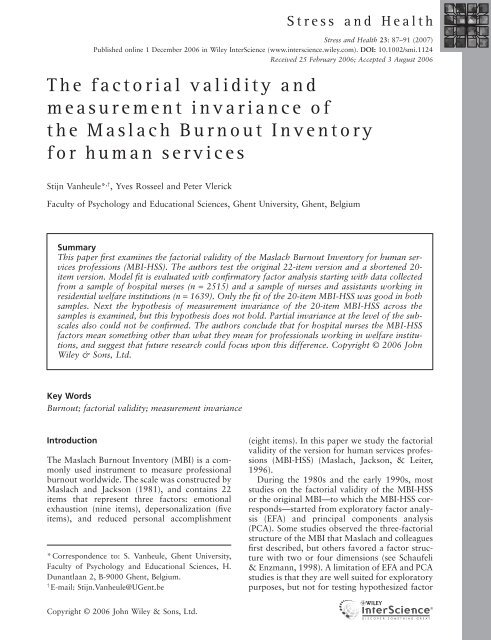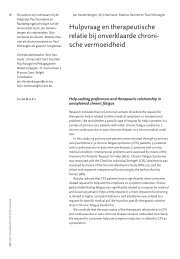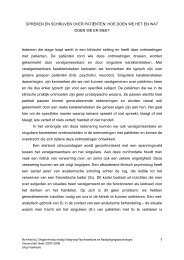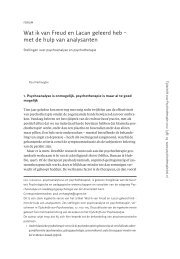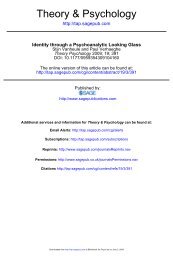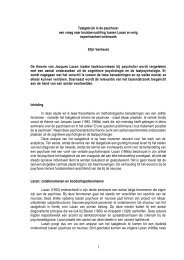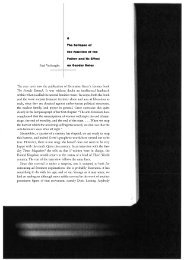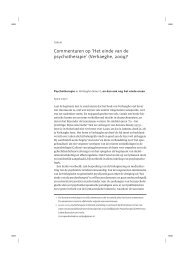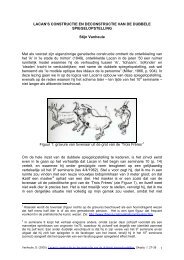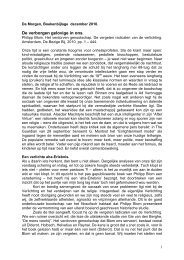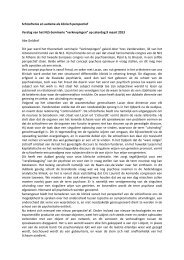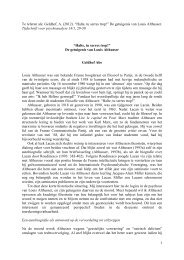The factorial validity and measurement invariance of the Maslach ...
The factorial validity and measurement invariance of the Maslach ...
The factorial validity and measurement invariance of the Maslach ...
Create successful ePaper yourself
Turn your PDF publications into a flip-book with our unique Google optimized e-Paper software.
Stress <strong>and</strong> Health<br />
Stress <strong>and</strong> Health 23: 87–91 (2007)<br />
Published online 1 December 2006 in Wiley InterScience (www.interscience.wiley.com). DOI: 10.1002/smi.1124<br />
Received 25 February 2006; Accepted 3 August 2006<br />
<strong>The</strong> <strong>factorial</strong> <strong>validity</strong> <strong>and</strong><br />
<strong>measurement</strong> <strong>invariance</strong> <strong>of</strong><br />
<strong>the</strong> <strong>Maslach</strong> Burnout Inventory<br />
for human services<br />
Stijn Vanheule* ,† , Yves Rosseel <strong>and</strong> Peter Vlerick<br />
Faculty <strong>of</strong> Psychology <strong>and</strong> Educational Sciences, Ghent University, Ghent, Belgium<br />
Summary<br />
This paper first examines <strong>the</strong> <strong>factorial</strong> <strong>validity</strong> <strong>of</strong> <strong>the</strong> <strong>Maslach</strong> Burnout Inventory for human services<br />
pr<strong>of</strong>essions (MBI-HSS). <strong>The</strong> authors test <strong>the</strong> original 22-item version <strong>and</strong> a shortened 20-<br />
item version. Model fit is evaluated with confirmatory factor analysis starting with data collected<br />
from a sample <strong>of</strong> hospital nurses (n = 2515) <strong>and</strong> a sample <strong>of</strong> nurses <strong>and</strong> assistants working in<br />
residential welfare institutions (n = 1639). Only <strong>the</strong> fit <strong>of</strong> <strong>the</strong> 20-item MBI-HSS was good in both<br />
samples. Next <strong>the</strong> hypo<strong>the</strong>sis <strong>of</strong> <strong>measurement</strong> <strong>invariance</strong> <strong>of</strong> <strong>the</strong> 20-item MBI-HSS across <strong>the</strong><br />
samples is examined, but this hypo<strong>the</strong>sis does not hold. Partial <strong>invariance</strong> at <strong>the</strong> level <strong>of</strong> <strong>the</strong> subscales<br />
also could not be confirmed. <strong>The</strong> authors conclude that for hospital nurses <strong>the</strong> MBI-HSS<br />
factors mean something o<strong>the</strong>r than what <strong>the</strong>y mean for pr<strong>of</strong>essionals working in welfare institutions,<br />
<strong>and</strong> suggest that future research could focus upon this difference. Copyright © 2006 John<br />
Wiley & Sons, Ltd.<br />
Key Words<br />
Burnout; <strong>factorial</strong> <strong>validity</strong>; <strong>measurement</strong> <strong>invariance</strong><br />
Introduction<br />
<strong>The</strong> <strong>Maslach</strong> Burnout Inventory (MBI) is a commonly<br />
used instrument to measure pr<strong>of</strong>essional<br />
burnout worldwide. <strong>The</strong> scale was constructed by<br />
<strong>Maslach</strong> <strong>and</strong> Jackson (1981), <strong>and</strong> contains 22<br />
items that represent three factors: emotional<br />
exhaustion (nine items), depersonalization (five<br />
items), <strong>and</strong> reduced personal accomplishment<br />
* Correspondence to: S. Vanheule, Ghent University,<br />
Faculty <strong>of</strong> Psychology <strong>and</strong> Educational Sciences, H.<br />
Dunantlaan 2, B-9000 Ghent, Belgium.<br />
† E-mail: Stijn.Vanheule@UGent.be<br />
(eight items). In this paper we study <strong>the</strong> <strong>factorial</strong><br />
<strong>validity</strong> <strong>of</strong> <strong>the</strong> version for human services pr<strong>of</strong>essions<br />
(MBI-HSS) (<strong>Maslach</strong>, Jackson, & Leiter,<br />
1996).<br />
During <strong>the</strong> 1980s <strong>and</strong> <strong>the</strong> early 1990s, most<br />
studies on <strong>the</strong> <strong>factorial</strong> <strong>validity</strong> <strong>of</strong> <strong>the</strong> MBI-HSS<br />
or <strong>the</strong> original MBI—to which <strong>the</strong> MBI-HSS corresponds—started<br />
from exploratory factor analysis<br />
(EFA) <strong>and</strong> principal components analysis<br />
(PCA). Some studies observed <strong>the</strong> three-<strong>factorial</strong><br />
structure <strong>of</strong> <strong>the</strong> MBI that <strong>Maslach</strong> <strong>and</strong> colleagues<br />
first described, but o<strong>the</strong>rs favored a factor structure<br />
with two or four dimensions (see Schaufeli<br />
& Enzmann, 1998). A limitation <strong>of</strong> EFA <strong>and</strong> PCA<br />
studies is that <strong>the</strong>y are well suited for exploratory<br />
purposes, but not for testing hypo<strong>the</strong>sized factor<br />
Copyright © 2006 John Wiley & Sons, Ltd.
S. Vanheule, Y. Rosseel <strong>and</strong> P. Vlerick<br />
structures (see Kalliath, O’Driscoll, Gillespie, &<br />
Bluedorn, 2000). For <strong>the</strong> latter, confirmatory<br />
factor analysis (CFA) is more appropriate. CFA<br />
tests whe<strong>the</strong>r <strong>and</strong> how well hypo<strong>the</strong>tical models<br />
<strong>of</strong> <strong>the</strong> mutual relations between items <strong>and</strong> factors<br />
fit empirical data (Hoyle, 1995).<br />
From <strong>the</strong> 1990s onward CFA has been increasingly<br />
used for testing <strong>the</strong> factor structure <strong>of</strong> <strong>the</strong><br />
MBI-HSS. A recurrent finding is that <strong>the</strong> model<br />
fit for <strong>the</strong> original 22-item MBI-HSS (MBI-HSS-<br />
22) is poor (e.g. Byrne, 1994; Kalliath et al.,<br />
2000). Some authors preferred to overcome this<br />
problem by accepting correlations between <strong>the</strong><br />
residual variances in <strong>the</strong> model <strong>and</strong> by allowing<br />
items to load on several factors in <strong>the</strong> tested<br />
model (e.g. Byrne, 1994). A problem <strong>of</strong> both<br />
approaches is that <strong>the</strong>y undermine unidimensional<br />
<strong>measurement</strong> <strong>of</strong> concepts. Moreover, very<br />
few <strong>the</strong>oretical arguments justify <strong>the</strong>se types <strong>of</strong><br />
solutions (see Kalliath et al., 2000). Removing<br />
items that cause misfit in a hypo<strong>the</strong>sized factor is<br />
a more straightforward strategy, but only makes<br />
sense if <strong>the</strong> model thus obtained is fur<strong>the</strong>r<br />
validated.<br />
Several shortened models have been described<br />
in <strong>the</strong> literature. <strong>The</strong> one that most frequently<br />
recurs leaves out items 12 <strong>and</strong> 16, <strong>and</strong> several<br />
studies have observed acceptable-to-good fit for<br />
this 20-item MBI-HSS (MBI-HSS-20) (e.g. Gil-<br />
Monte, 2005; Hallberg & Sverke, 2004; Schaufeli<br />
& Van Dierendonck, 1993). Item 12 is a personal<br />
accomplishment item for which significant loadings<br />
on emotional exhaustion were consistently<br />
observed, <strong>and</strong> item 16 is an emotional exhaustion<br />
item for which significant loadings on depersonalization<br />
were consistently observed. Schaufeli<br />
<strong>and</strong> colleagues (Schaufeli, Bakker, Hoogduin,<br />
Schaap, & Kladler, 2001) demonstrated <strong>the</strong> clinical<br />
<strong>validity</strong> <strong>of</strong> <strong>the</strong> MBI-HSS-20. <strong>The</strong>y calculated<br />
cut-<strong>of</strong>f scores that discriminate between employees<br />
with work-related neuras<strong>the</strong>nia <strong>and</strong> those<br />
without it.<br />
What is interesting about <strong>the</strong> MBI-HSS-20 is<br />
that <strong>the</strong> same problematic items were identified<br />
by different groups <strong>of</strong> researchers, <strong>and</strong> that this<br />
version does not differ substantially from <strong>the</strong><br />
MBI-HSS-22. Both versions are considered equivalent<br />
(see Schaufeli & Enzmann, 1998). An<br />
important construct <strong>validity</strong>-related question that<br />
remains open is whe<strong>the</strong>r this model can be replicated<br />
in large samples. Moreover <strong>measurement</strong><br />
<strong>invariance</strong> across different human services pr<strong>of</strong>essions<br />
or sectors has not yet been studied for<br />
this model.<br />
O<strong>the</strong>r shortened models have been developed<br />
as well, mostly by removing still more items<br />
from <strong>the</strong> MBI-HSS-22. So-kum Tang (1998), for<br />
example, developed a 19-item model, <strong>and</strong><br />
Kalliath et al. (2000) a seven-item model. <strong>The</strong>se<br />
alternative shortened models were based on a<br />
single or limited number <strong>of</strong> samples <strong>and</strong> lack<br />
cross-validation. Because construct <strong>validity</strong> <strong>of</strong><br />
<strong>the</strong>se shortened versions has not been demonstrated,<br />
we suggest considering <strong>the</strong>se alternatives<br />
when <strong>the</strong> 20-item version has a poor model fit.<br />
In this article we study <strong>the</strong> <strong>factorial</strong> <strong>validity</strong> <strong>of</strong><br />
<strong>the</strong> MBI-HSS-22 <strong>and</strong> <strong>the</strong> MBI-HSS-20 by means<br />
<strong>of</strong> CFA <strong>and</strong> examine metric <strong>measurement</strong> <strong>invariance</strong><br />
by comparing data from hospital nurses<br />
to data from nurses <strong>and</strong> assistants in welfare<br />
institutions.<br />
Method<br />
Samples<br />
Two samples <strong>of</strong> human services pr<strong>of</strong>essionals<br />
were studied. <strong>The</strong> first sample (hospital sample)<br />
was composed <strong>of</strong> hospital nurses (n = 2515).<br />
<strong>The</strong>y were recruited in 15 Belgian general hospitals<br />
(response rate: 57 per cent). <strong>The</strong> average age<br />
was 32.0 (st<strong>and</strong>ard deviation, SD = 7.4); <strong>the</strong>y had<br />
been working in <strong>the</strong> sector for 9.0 years on<br />
average (SD = 7.2); <strong>and</strong> 83 per cent <strong>of</strong> <strong>the</strong> group<br />
was female. <strong>The</strong> second sample (welfare sample)<br />
was composed <strong>of</strong> nurses <strong>and</strong> assistants working<br />
in residential welfare institutions for youth with<br />
special needs, mentally disabled persons, or geriatric<br />
persons (n = 1639). <strong>The</strong>y were recruited in<br />
89 residential institutions in Belgium (response<br />
rate: 71 per cent). <strong>The</strong> average age was 35.0 (SD<br />
= 8.5); <strong>the</strong>y had been working in <strong>the</strong> sector for<br />
11.1 years on average (SD = 8.0); <strong>and</strong> 81.4 per<br />
cent <strong>of</strong> <strong>the</strong> group was female. All questionnaires<br />
were distributed with a cover letter that asked for<br />
anonymous participation <strong>and</strong> for informed<br />
consent, <strong>and</strong> were collected through letterboxes<br />
installed in all participating institutions.<br />
Measures<br />
We used <strong>the</strong> Flemish version <strong>of</strong> <strong>the</strong> MBI, which<br />
was obtained through translation <strong>and</strong> backtranslation<br />
(Vlerick, 1993). Previous EFA indicated<br />
a three-<strong>factorial</strong> structure underlying <strong>the</strong><br />
items similar to <strong>the</strong> one <strong>Maslach</strong> <strong>and</strong> Jackson<br />
88<br />
Copyright © 2006 John Wiley & Sons, Ltd. Stress <strong>and</strong> Health 23: 87–91 (2007)<br />
DOI: 10.1002/smi
<strong>Maslach</strong> Burnout Inventory for human services<br />
(1981) described (Vlerick, 1993), but CFAs<br />
did not observe good fit for <strong>the</strong> 22-item version<br />
(Vanheule, Rosseel, & Bogaerts, 2005; Vlerick,<br />
1995). All items ask for frequencies <strong>and</strong> are<br />
scored on a seven-point Likert scale.<br />
Analysis<br />
CFAs were conducted with Lisrel 8.72 using MLestimation<br />
<strong>and</strong> Satorra–Bentler corrections. We<br />
fitted <strong>the</strong> factor-structure model described by<br />
<strong>Maslach</strong> et al. (1996). Model fit was evaluated<br />
starting from: (1) <strong>the</strong> Comparative Fit Index<br />
(CFI) based on <strong>the</strong> minimum fit function Chisquare,<br />
for which values >0.90 indicate good fit;<br />
(2) <strong>the</strong> Tucker–Lewis Index (TLI) based on <strong>the</strong><br />
minimum fit function Chi-square, for which<br />
values <strong>of</strong> >0.90 indicate good fit; (3) <strong>the</strong> St<strong>and</strong>ardized<br />
Root Mean Square Residual (SRMR),<br />
for which values
S. Vanheule, Y. Rosseel <strong>and</strong> P. Vlerick<br />
Figure 1. Path diagram with st<strong>and</strong>ardized factorloadings<br />
<strong>of</strong> <strong>the</strong> 20-item MBI-HSS in <strong>the</strong> welfare sample<br />
(n = 1639): EE = emotional exhaustion, DP = depersonalization,<br />
PA = personal accomplishment.<br />
Figure 2. Path diagram with st<strong>and</strong>ardized factorloadings<br />
<strong>of</strong> <strong>the</strong> 20-item MBI-HSS in <strong>the</strong> hospital<br />
sample (n = 2515): EE = emotional exhaustion, DP =<br />
depersonalization, PA = personal accomplishment.<br />
Table III Test <strong>of</strong> partial <strong>measurement</strong> <strong>invariance</strong> <strong>of</strong><br />
<strong>the</strong> 20-item MBI-HSS.<br />
Partial <strong>invariance</strong> models Chi-square df p<br />
MBI-HSS-20<br />
difference<br />
EE free, DP <strong>and</strong> PA fixed 100.14 10
<strong>Maslach</strong> Burnout Inventory for human services<br />
unidimensional subscales that measure <strong>the</strong><br />
burnout dimensions as defined by <strong>Maslach</strong> <strong>and</strong><br />
Jackson (see Schaufeli & Enzmann, 1998).<br />
A subsequent test <strong>of</strong> <strong>measurement</strong> <strong>invariance</strong><br />
indicated that <strong>the</strong> factor-structure model is not<br />
invariant across both samples. Nei<strong>the</strong>r could<br />
partial <strong>invariance</strong> at <strong>the</strong> level <strong>of</strong> <strong>the</strong> subscales be<br />
assumed. This means that <strong>the</strong> loadings <strong>of</strong> <strong>the</strong><br />
items on <strong>the</strong> factors are substantially different in<br />
both samples, <strong>and</strong> suggests that <strong>the</strong> interpretation<br />
<strong>of</strong> <strong>the</strong> meaning <strong>of</strong> emotional exhaustion, depersonalization,<br />
<strong>and</strong> reduced personal accomplishment<br />
is sample specific. For hospital nurses <strong>the</strong><br />
three MBI-HSS factors seem to mean something<br />
o<strong>the</strong>r than what <strong>the</strong>y mean for human service<br />
pr<strong>of</strong>essionals employed in welfare institutions.<br />
We think this is influenced by differences in job<br />
content, work circumstances, <strong>and</strong> pr<strong>of</strong>essional<br />
goals in <strong>the</strong> respective sectors. Given <strong>the</strong> fact that<br />
only scant attention in <strong>the</strong> literature on <strong>the</strong> MBI-<br />
HSS has been devoted to <strong>the</strong> particular meaning<br />
<strong>of</strong> <strong>the</strong> three dimensions underlying burnout in<br />
different occupational groups, we suggest that<br />
future research would do well to focus on it. This<br />
type <strong>of</strong> research could contribute to <strong>the</strong> fur<strong>the</strong>r<br />
development <strong>of</strong> occupation-specific knowledge<br />
<strong>and</strong> interventions with respect to burnout.<br />
References<br />
Byrne, B.M. (1994). Testing for <strong>the</strong> <strong>factorial</strong> <strong>validity</strong>, replication,<br />
<strong>and</strong> <strong>invariance</strong> <strong>of</strong> a measuring instrument: a paradigmatic<br />
application based on <strong>the</strong> <strong>Maslach</strong> Burnout Inventory.<br />
Multivariate Behavioral Research, 29, 289–311.<br />
Gil-Monte, P.R. (2005). Factorial <strong>validity</strong> <strong>of</strong> <strong>the</strong> <strong>Maslach</strong><br />
Burnout Inventory (MBI-HSS) among Spanish pr<strong>of</strong>essionals.<br />
Revista Saude Publica, 39, 1–8.<br />
Hallberg, U.E., & Sverke, M. (2004). Construct <strong>validity</strong> <strong>of</strong> <strong>the</strong><br />
<strong>Maslach</strong> Burnout Inventory: Two Swedish health care<br />
samples. European Journal <strong>of</strong> Psychological Assessment,<br />
20, 320–338.<br />
Hoyle, R.H. (1995). Structural equation modelling—Concepts,<br />
issues <strong>and</strong> applications. London: Sage.<br />
Kalliath, T.J., O’Driscoll, M.P., Gillespie, D.F., & Bluedorn,<br />
A.C. (2000). A test <strong>of</strong> <strong>the</strong> <strong>Maslach</strong> Burnout Inventory in<br />
three samples <strong>of</strong> healthcare pr<strong>of</strong>essionals. Work & Stress,<br />
14, 35–50.<br />
<strong>Maslach</strong>, C., & Jackson, S.E. (1981). <strong>Maslach</strong> Burnout Inventory.<br />
Research edition. Palo Alto, CA: Consulting Psychologist<br />
Press.<br />
<strong>Maslach</strong>, C., Jackson, S.E., & Leiter, M. (1996). <strong>Maslach</strong><br />
Burnout Inventory. Manual (3rd ed.). Palo Alto, CA: Consulting<br />
Psychologist Press.<br />
Muthén, L., & Muthén, B. (2005). Chi-square difference<br />
testing using <strong>the</strong> S-B scaled chi-square. Note on M-plus<br />
website. Retrieved February 1, 2006 from http://www.<br />
statmodel.com<br />
Schaufeli, W.B., & Enzmann, D. (1998). <strong>The</strong> burnout companion<br />
to study <strong>and</strong> research: A critical analysis. London:<br />
Taylor & Francis.<br />
Schaufeli, W.B., & Van Dierendonck, D. (1993). <strong>The</strong> construct<br />
<strong>validity</strong> <strong>of</strong> two burnout measures. Journal <strong>of</strong> Organizational<br />
Behavior, 14, 631–647.<br />
Schaufeli, W.B., Bakker, A.B., Hoogduin, K., Schaap, C., &<br />
Kladler, A. (2001). On <strong>the</strong> clinical <strong>validity</strong> <strong>of</strong> <strong>the</strong> <strong>Maslach</strong><br />
Burnout Inventory <strong>and</strong> <strong>the</strong> Burnout Measure. Psychology<br />
<strong>and</strong> Health, 16, 565–582.<br />
So-kum Tang, C. (1998). Assessment <strong>of</strong> burnout for Chinese<br />
human service pr<strong>of</strong>essionals: A study <strong>of</strong> <strong>factorial</strong> <strong>validity</strong><br />
<strong>and</strong> <strong>invariance</strong>. Journal <strong>of</strong> Clinical Psychology, 54, 55–58.<br />
Vanheule, S., Rosseel, Y., & Bogaerts, S. (2005). Measuring<br />
pr<strong>of</strong>essional burnout in Dutch-speaking regions: An evaluation<br />
<strong>of</strong> <strong>the</strong> <strong>factorial</strong> <strong>validity</strong> <strong>of</strong> <strong>the</strong> <strong>Maslach</strong> Burnout Inventory.<br />
Psychologica Belgica, 45, 147–156.<br />
Vlerick, P. (1993). Exploratieve analyse van de factoriële<br />
validiteit van de <strong>Maslach</strong> Burnout Inventory. Tijdschrift<br />
Klinische Psychologie, 23, 235–250.<br />
Vlerick, P. (1995). Confirmatorische analyse van de factorstructuur<br />
en de validiteit van de <strong>Maslach</strong> Burnout Inventory.<br />
Gedrag & Gezondheid, 32, 35–40.<br />
Copyright © 2006 John Wiley & Sons, Ltd. Stress <strong>and</strong> Health 23: 87–91 (2007)<br />
DOI: 10.1002/smi<br />
91


